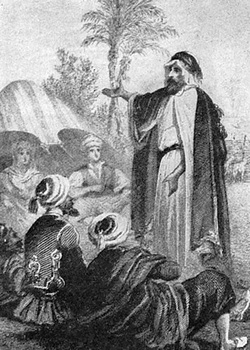Arab Rule (636-1099)

The Islamic prophet Muhammad teaches fellow Arabs.
As the Arab/Muslim Empire originally led by Muhammad conquered Israel in a campaign of much of the world, irreversible tensions and differences emerged between the Jewish population and the Muslim settlers. The Arabs and the Muslims are often associated with each other because around 571 AD, a man named Muhammad united almost all Middle Eastern tribes under Islam from the city of Mecca. Because of this strong unity and the large number of settlements in the Middle East, the Arabs had much military might and captured a huge amount of land, extending their empire into parts of Europe. As they captured the ancient land of Israel, that had been taken from empire to empire for thousands of years, the mainly Muslim inhabitants were descendants of the Palestinians that would later feud with the Jews over the land.
The Jewish population of Israel at the time was fairly low, because of the Diaspora, but small Jewish settlements still existed. The Arab rulers of the land, however, were extremely cruel and persecuted anyone who was not Muslim and lived there. Generally, the measure of harshness depended on the ruler of the Arab empire at the time. Some Jews even advanced in mathematics, culture, and art under Muslim rule in Palestine with great conditions compared to Jews in Europe facing persecution. The Muslims even let Jews settle in Jerusalem, allowing them to return to their ancestor's land. The harshness or brutality
This was not the last time a Muslim empire controlled Israel. The Ottoman Empire (the Turks) would also take Palestine later in the 18th century up until the British Mandate of Palestine. This would add to the religious tension and increase the desire for a permanent Jewish homeland.
The Jewish population of Israel at the time was fairly low, because of the Diaspora, but small Jewish settlements still existed. The Arab rulers of the land, however, were extremely cruel and persecuted anyone who was not Muslim and lived there. Generally, the measure of harshness depended on the ruler of the Arab empire at the time. Some Jews even advanced in mathematics, culture, and art under Muslim rule in Palestine with great conditions compared to Jews in Europe facing persecution. The Muslims even let Jews settle in Jerusalem, allowing them to return to their ancestor's land. The harshness or brutality
This was not the last time a Muslim empire controlled Israel. The Ottoman Empire (the Turks) would also take Palestine later in the 18th century up until the British Mandate of Palestine. This would add to the religious tension and increase the desire for a permanent Jewish homeland.
